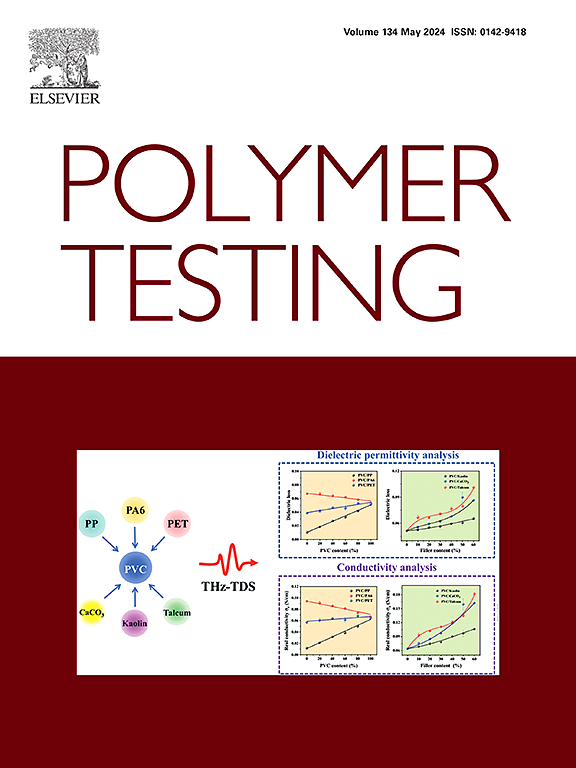Investigation of color formation and H2O2-assisted decolorization in CO2-derived polyhydroxyurethane
IF 5
2区 材料科学
Q1 MATERIALS SCIENCE, CHARACTERIZATION & TESTING
引用次数: 0
Abstract
CO2-derived polyhydroxyurethane (PHU), synthesized via the aminolysis of cyclic carbonate, faces limitations in replacing conventional polyurethane (PU) for color-sensitive applications due to its yellow color. In this study, we investigate, for the first time, the coloration pathways in PHU and explore the use of hydrogen peroxide (H2O2) to eliminate polymer color. Model compounds, resembling a PHU repeating unit, are prepared from CO2-derived bis(cyclic carbonate) and monoamines and then thermally aged to trace the color-forming species. Observations of the changes in Fourier-transfer infrared spectroscopy and mass spectrometry indicate multi-pathway thermal oxidation to occur at both the nitrogen-vicinal and the oxygen-vicinal methylene carbon adjacent to the urethane linkage. The changes track well with an increase in the model compound's color index as determined from UV–visible spectra, providing an explanation for PHU's susceptibility to coloration. The colored model compound and PHU are then subjected to H2O2 treatment to disrupt the conjugated carbonyl groups and thus reduce the color. Parameters, including H2O2 concentration, treatment time, and temperature, are examined for a linear PHU system, and a set of optimized treatment conditions are implemented to yield PHU with reduced color and minimal damage to its molecular structure. The decolorization method developed in this study could be extended beyond PHU to treat polymeric materials that suffer from oxidation-induced coloration issues.

二氧化碳衍生聚羟基聚氨酯的显色及h2o2辅助脱色研究
二氧化碳衍生的聚羟基聚氨酯(PHU)是通过环碳酸酯氨解合成的,由于其颜色偏黄,在取代传统聚氨酯(PU)用于色敏应用方面受到限制。在这项研究中,我们首次研究了PHU中的显色途径,并探索了使用过氧化氢(H2O2)来消除聚合物的显色。模型化合物类似于PHU重复单元,由二氧化碳衍生的双(环碳酸盐)和单胺制备,然后热老化以追踪形成颜色的物种。傅里叶转移红外光谱和质谱的变化表明,在氨基甲酸乙酯键附近的氮邻基亚甲基碳和氧邻基亚甲基碳都发生了多途径的热氧化。这些变化与模型化合物的显色指数的增加很好地跟踪,从紫外可见光谱确定,为PHU对显色的敏感性提供了解释。然后将着色的模型化合物和PHU进行H2O2处理,以破坏共轭羰基,从而降低颜色。研究了线性PHU体系的H2O2浓度、处理时间和温度等参数,优化了PHU的处理条件,得到了颜色较低、对分子结构破坏最小的PHU。在本研究中开发的脱色方法可以扩展到PHU之外,以处理受氧化引起的变色问题的聚合物材料。
本文章由计算机程序翻译,如有差异,请以英文原文为准。
求助全文
约1分钟内获得全文
求助全文
来源期刊

Polymer Testing
工程技术-材料科学:表征与测试
CiteScore
10.70
自引率
5.90%
发文量
328
审稿时长
44 days
期刊介绍:
Polymer Testing focuses on the testing, analysis and characterization of polymer materials, including both synthetic and natural or biobased polymers. Novel testing methods and the testing of novel polymeric materials in bulk, solution and dispersion is covered. In addition, we welcome the submission of the testing of polymeric materials for a wide range of applications and industrial products as well as nanoscale characterization.
The scope includes but is not limited to the following main topics:
Novel testing methods and Chemical analysis
• mechanical, thermal, electrical, chemical, imaging, spectroscopy, scattering and rheology
Physical properties and behaviour of novel polymer systems
• nanoscale properties, morphology, transport properties
Degradation and recycling of polymeric materials when combined with novel testing or characterization methods
• degradation, biodegradation, ageing and fire retardancy
Modelling and Simulation work will be only considered when it is linked to new or previously published experimental results.
 求助内容:
求助内容: 应助结果提醒方式:
应助结果提醒方式:


